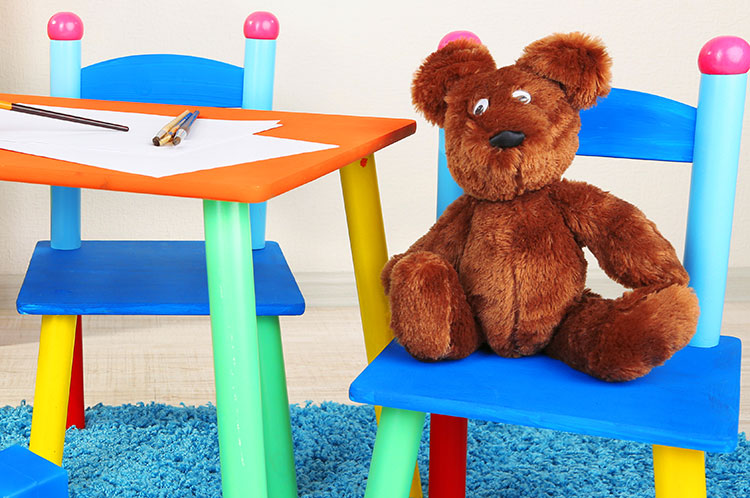B6: Fill in the Rhyme
1. Overview
Complete phrases and sentences with rhyming words. Your child will learn to rely on contextual cues to create rhymes.
“The bear is sitting on a chair.”
2. Materials
↑ Top3. Activity
Introduce this activity to your child by reading a couple of the rhyming sentences above to her, emphasizing the rhyming words and asking her to repeat the rhyming words. Then ask if she can finish the next sentence by saying the right rhyming word. She will have to come up with the word that rhymes with the emphasized word in the sentence and also makes sense in the context of the sentence.Video: How to play Fill in the Rhyme
↑ Top
4. Confidence Builder
If it seems your child is not quite ready for the activity above, try this one instead. Sing the song “Happy Birthday to You” with these alternate lyrics. I saw a frog chase a hog, I saw a frog chase a hog. I could not believe it! I saw a frog chase a hog! I saw a bat chase a ____, [Let child fill in blank with a rhyming word] I saw a… You can also do this activity with the song “Down by the Bay.” The structure of these songs will help cement the rhyming structure in the child’s mind. A few more tips for a child who struggles with this activity:- If you feel your child is just being careless, try the item again.
- If your child isn’t getting the concept, back up one or two lessons.
- If the child is simply unable to rhyme, that’s okay. Skip ahead to the Sentences and Words module. Return to the Rhyming module later and try this activity again.
5. Extension
Once your child has a firm grasp of the art of rhyming, have her create her own rhyming sentences. They can be silly rhymes (e.g., The tree grew into a flea), as long as they are true rhymes. For example, gently correct the child if she tries to rhyme bone and home. ↑ Top6. Small Groups (2-5 children)
Lesson Objective: Children will be able to hear incomplete sentences and use context clues to create ending rhymes. GELDS (Georgia Early Learning & Development Standards): CLL6.4b Georgia Standards of Excellence: ELAGSEKRF2.a Common Core State Standards: CCSS.ELA-LITERACY.RF.K.2.A Adaptation: Read the main activity, watch the video, and follow the instructions above, with the following changes: Let the children work in pairs. Give one child at a time a rhyming sentence to complete. The first child fills in the blank in the sentence. The second child then repeats the two rhyming words. Here’s an example:Adult: The fox ran out of the . Child A: The fox ran out of the … box! Child B: Fox and box.Reinforcement: Repeat the adaptation above, but switch tasks. Child B will now fill in the rhyme, and Child A will name the rhyming words. Use this Reinforcement at Home form to tell parents and guardians how they can reinforce lessons outside the classroom. ↑ Top
Leave a Reply


2 Responses to “B6: Fill in the Rhyme”
Kelsie
Some of the links in this article are broken.
Sight Words Admin
Sorry to hear you’ve been having trouble. Could you indicate which specific links are broken? We’ve checked the links on our end, and everything checks out as of this writing.